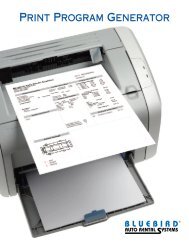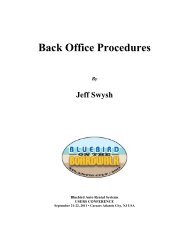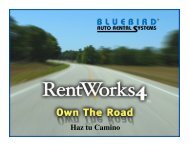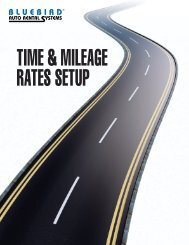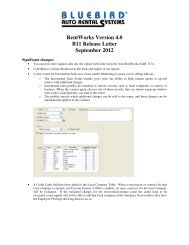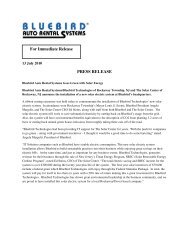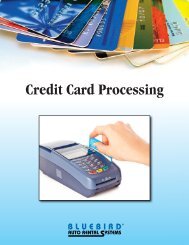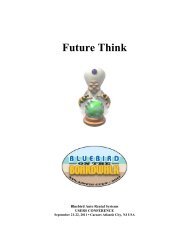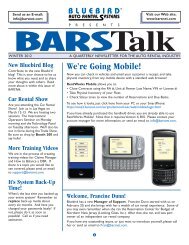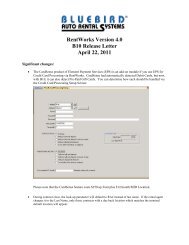RentWorks 4.0 - Bluebird Auto Rental Systems
RentWorks 4.0 - Bluebird Auto Rental Systems
RentWorks 4.0 - Bluebird Auto Rental Systems
Create successful ePaper yourself
Turn your PDF publications into a flip-book with our unique Google optimized e-Paper software.
<strong>RentWorks</strong><br />
Version 4<br />
Release Letter<br />
© 2008 <strong>Bluebird</strong> <strong>Auto</strong> <strong>Rental</strong> <strong>Systems</strong> (BARS) Last Update 9/17/2012 1:04:41 PM
<strong>RentWorks</strong> Version 4 Release Letter<br />
<strong>RentWorks</strong> Version 4<br />
Release Letter<br />
June 5, 2008<br />
Table of Contents<br />
Introduction .................................................................2<br />
New Architecture ........................................................4<br />
Main Menu ..................................................................5<br />
Dashboard ...................................................................6<br />
Toolbars ......................................................................7<br />
Reports ........................................................................8<br />
Language Translations ................................................9<br />
Miscellaneous New Features ....................................10<br />
Application Server ....................................................12<br />
WebClient .................................................................13<br />
Future Release Enhancements ..................................14<br />
© Copyright 2008 by <strong>Bluebird</strong> <strong>Auto</strong> <strong>Rental</strong> <strong>Systems</strong> (BARS). All rights reserved. No part of this document may be reproduced, stored in a<br />
retrieval system, or transcribed in any form or by any means, electronic, mechanical, photocopying, recorded or otherwise, without the prior<br />
written consent of the publisher, BARS.<br />
BARS makes no express, or implied warranty of any kind, including, but not limited to, the implied warranties of merchantability and fitness for<br />
a particular purpose, with regard to the program material contained herein. BARS shall not be liable for incidental or consequential damages in<br />
connection with or arising out of the furnishing, performance or use of this material.<br />
© 2008 <strong>Bluebird</strong> <strong>Auto</strong> <strong>Rental</strong> <strong>Systems</strong> (BARS) 1
<strong>RentWorks</strong> Version 4 Release Letter<br />
Introduction<br />
This document describes some of the new features that are included in <strong>RentWorks</strong> version 4.<br />
While there are many new features in version 4, it is important to recognize that this new release<br />
represents a significant step forward in terms of technology and system architecture. With the<br />
release of version 4, <strong>RentWorks</strong> is positioned to implement the latest technologies available –<br />
such as Service-Oriented Architecture (SOA) and Web Services.<br />
<strong>RentWorks</strong> version 4 uses Progress Software’s WebClient to deliver the application to the<br />
local desktop. WebClient downloads <strong>RentWorks</strong> from a Web Server to the local drive where it<br />
runs. This configuration has the advantage of using local processing power and memory on the<br />
desktop to run the application, as opposed to using resources on the server which will allow more<br />
users to run from a single server than has been possible in the past. In addition, the application<br />
will have access to any printer that the local PC has access to, whether directly attached or<br />
networked.<br />
When the local instance of <strong>RentWorks</strong> needs to read (or write) data from the <strong>RentWorks</strong><br />
database, a request is sent to the Application Server (“App Server”) which resides on the same<br />
server (or LAN) as the <strong>RentWorks</strong> database. The App Server has agents waiting to service<br />
requests, and makes the necessary connection to the database. As data is fetched from the<br />
database the App Server passes it to the local client.<br />
Remote Desktop Protocol (RDP) will no longer be necessary.<br />
Requirements For Installing Version 4<br />
<strong>RentWorks</strong> Service Pack 6<br />
Progress 10.1B with service pack 3.<br />
<br />
<br />
<br />
For on-premises customers who still want to use Client Networking and RDP, thin client<br />
terminals must support 1024 by 768 with 16–bit color (or higher).<br />
NetRent users will no longer use RDP and therefore cannot use thin client terminals.<br />
For SINGLE USER on-premises configurations, the database server must have at least a<br />
Pentium IV processor, 2GB RAM, and 250GB Disk. For multi-users, please contact us.<br />
Significant Changes to Your Configuration<br />
DOT MATRIX PRINTERS ARE NO LONGER SUPPORTED FOR REPORTS. However, they<br />
will be supported for rental agreements.<br />
The following apply to just NetRent users:<br />
<br />
<br />
<br />
HAND-HELD PRINTERS MUST SUPPORT BLUE TOOTH if you are on NetRent.<br />
RESULTS REPORT WRITER must be replaced with a custom report writer which will<br />
work with the WebClient.<br />
In order to email rental agreements to customers, a MAPI compliant email software<br />
package must reside on the Client PC.<br />
© 2008 <strong>Bluebird</strong> <strong>Auto</strong> <strong>Rental</strong> <strong>Systems</strong> (BARS) 2
<strong>RentWorks</strong> Version 4 Release Letter<br />
Introduction (continued)<br />
<br />
<br />
<br />
<br />
Progress Software’s AppServer license will be required for those on-premises customers<br />
who want to use WebClients. All NetRent users will be using WebClients. Advantages<br />
of a WebClient are:<br />
o The processing of the data takes place closer to the database, therefore speeding<br />
up the system.<br />
o Any printer can be used (including network printers) as WebClients also won’t<br />
require that all the printer drivers be loaded on the server.<br />
o Windows Terminal Services CALs will not be needed.<br />
o Every unique client device will require a license (per seat licensing). This will<br />
now be tracked with a new table within <strong>RentWorks</strong> version 4.<br />
AppServer does not include the ODBC drivers. However, if you use a report writer such<br />
as Crystal or Excel, you can download the free Sequel Client Access product from the<br />
Progress website. (You’ll need the License Codes for your server database to do so.)<br />
For new version 4 installations, one “Client Networking” license will still be needed for<br />
server functions such as the Report Monitor.<br />
In order to email reservation receipts, the only supported email system is Microsoft<br />
Outlook.<br />
© 2008 <strong>Bluebird</strong> <strong>Auto</strong> <strong>Rental</strong> <strong>Systems</strong> (BARS) 3
<strong>RentWorks</strong> Version 4 Release Letter<br />
New Architecture<br />
<strong>RentWorks</strong> 4 is built following the Progress OpenEdge<br />
Reference Architecture (OERA). The application’s<br />
functionality is broken up into different layers, with each<br />
layer having a specific purpose. Data passes in between these<br />
layers, from the database up to the user.<br />
The layers include:<br />
Presentation Layer – The user interface; everything a user sees on the screen is in this layer.<br />
Integration Layer – Links to external programs, such as API’s.<br />
Business Servicing Layer – The bulk of the business logic; calculations and business processes<br />
are in this layer.<br />
Data Access Layer – This layer includes data validation and the process of reading and writing<br />
data from sources such as a database or flat files.<br />
Splitting <strong>RentWorks</strong> into these different layers makes the application more flexible. The<br />
database can be located separately from the application programs. New interfaces can be added<br />
on more easily. And new user interfaces can run off the same set of business logic.<br />
© 2008 <strong>Bluebird</strong> <strong>Auto</strong> <strong>Rental</strong> <strong>Systems</strong> (BARS) 4
<strong>RentWorks</strong> Version 4 Release Letter<br />
Main Menu<br />
Because of all the new environments now<br />
supported, the login screen will indicate<br />
which is being used:<br />
CS = Client/Server<br />
AS = AppServer<br />
WC = WebClient<br />
<strong>RentWorks</strong> has been enhanced to fill the entire screen at<br />
1024 x 768 resolution. The main menu features a panel on the<br />
left (the menu bar) that allows the user to select a program to<br />
run. The selected program will run in the area to the right side<br />
of the screen (the data entry area). The user never has to leave<br />
the main menu to run any program within <strong>RentWorks</strong>.<br />
There is a new Favorites area on the main menu where<br />
users can position their most commonly accessed programs.<br />
The Favorites folder is user-specific and can therefore be<br />
customized for each employee.<br />
Also new in version 4, users can open multiple programs at the same time. Each new<br />
program opened creates another tab on the data entry side of the screen. Users can switch<br />
between programs by clicking on the various tabs they have open in the data entry area.<br />
© 2008 <strong>Bluebird</strong> <strong>Auto</strong> <strong>Rental</strong> <strong>Systems</strong> (BARS) 5
<strong>RentWorks</strong> Version 4 Release Letter<br />
Dashboard<br />
The Dashboard displays four sections of graphs and data that will allow users to monitor<br />
critical business statistics such as the fleet status, number of reservations, and source of business.<br />
The Snapshot counts the number of contracts opened and closed, along with the number of walkups.<br />
The Dashboard can be customized to each user’s needs in how it displays (pie or line chart,<br />
bar graph, or raw data) and what selection criteria is used (locations, date range, and frequency<br />
of updating.)<br />
© 2008 <strong>Bluebird</strong> <strong>Auto</strong> <strong>Rental</strong> <strong>Systems</strong> (BARS) 6
<strong>RentWorks</strong> Version 4 Release Letter<br />
Toolbars<br />
Moveable Toolbars<br />
New standard navigation and record editing toolbars have been added to perform common<br />
actions such as Find First, Previous, Next, New, Add, Copy, Edit, Delete, Undo and Save.<br />
The toolbars can be moved around to different places at the<br />
top of the screen, or it can be detached altogether and left<br />
“floating” above the screen.<br />
The new toolbars will be contextual, in that they will<br />
change on-the-fly as the user navigates between different<br />
screens and tabs. Irrelevant buttons will disappear, replaced by new buttons that are specific to<br />
the screen that the user is currently working on.<br />
© 2008 <strong>Bluebird</strong> <strong>Auto</strong> <strong>Rental</strong> <strong>Systems</strong> (BARS) 7
<strong>RentWorks</strong> Version 4 Release Letter<br />
Reports<br />
Reports are now run separate from the client session. This means that running a report no<br />
longer takes control of <strong>RentWorks</strong>, forcing you to wait until the report is done before you can do<br />
anything else. Now reports run in the background so you can continue working while it runs.<br />
You will be alerted when the report has completed.<br />
New Output Options<br />
In addition to sending output to a printer, file or the terminal, all reports can now be sent to a<br />
Portable Document Format (PDF) file so that they can easily be emailed.<br />
Scheduling Reports<br />
Reports can be scheduled to run at a later date and time. A ‘Schedule’ button on<br />
the toolbar lets you set a date and time for the report to begin.<br />
Report Inquiry<br />
A new inquiry allows you to view previously-run reports. The inquiry shows each report job<br />
along with its status (i.e. scheduled, completed, etc.) The completed reports can be resent to<br />
multiple output destinations.<br />
Daily Business Report<br />
To post a Daily Business Report, you now need to go to Reports->Management Reports-<br />
>Accounting, and select DBR Posting.<br />
The Daily Business Report under Counter Reports->Close of Day no longer has a posting<br />
option.<br />
© 2008 <strong>Bluebird</strong> <strong>Auto</strong> <strong>Rental</strong> <strong>Systems</strong> (BARS) 8
<strong>RentWorks</strong> Version 4 Release Letter<br />
Language Translations<br />
To provide screens in different languages, <strong>RentWorks</strong> Version 4 will give users the<br />
opportunity to translate field labels.<br />
Note: Report labels and headings, plus any error messages, will still be in English.<br />
© 2008 <strong>Bluebird</strong> <strong>Auto</strong> <strong>Rental</strong> <strong>Systems</strong> (BARS) 9
<strong>RentWorks</strong> Version 4 Release Letter<br />
Miscellaneous New Features<br />
Progression Bar<br />
In the Reservation and Counter Processing screens, there is a new “progression bar” which<br />
shows how many steps there are to completing the transaction.<br />
Employee Groups<br />
In version 3, there was numeric level Menu and Field Security and Job Types. In version 4,<br />
both are replaced with Employee Groups.<br />
Groups are user definable with the old Version 3 job types being created at conversion time.<br />
The conversion will associate an employee with whatever groups they used to have assigned as<br />
job types. For example, if an employee had the job types of Accounting, Manager and <strong>Rental</strong><br />
Agent, they will now have those groups assigned to them automatically.<br />
Menu and Field Security is now secured by group affiliation. Both are maintained from a<br />
single program called Program Security in Settings > Security, which looks similar to the version<br />
3 Field Security screen. This screen allows you to define which groups have access to a field or<br />
menu item.<br />
Note: The default is for everyone to have access to everything.<br />
Address Verification<br />
If you use Central Coast Processing for credit card authorizations, there is now a feature to have<br />
the card holder’s billing address verified.<br />
When an authorization attempt is performed the renters address information is passed along to<br />
Central Coast Processing. An AVS response is sent back with the authorization request and<br />
handled according to your setup. You define responses that should either fail or warn the rental<br />
agent. In the case of a failed response code, the rental agent is notified and the deposit/payment<br />
transaction is voided. If the response code is setup to warn the user, they are presented with the<br />
response message and then allowed to continue the transaction or void it. Below is a list of<br />
possible responses:<br />
Reason Code<br />
A<br />
G<br />
N<br />
Reason Text<br />
Address matches, postal code does not<br />
Non-AVS participant outside the U.S.; address not verified for<br />
international transactions<br />
Neither address nor postal code matches<br />
© 2008 <strong>Bluebird</strong> <strong>Auto</strong> <strong>Rental</strong> <strong>Systems</strong> (BARS) 10
<strong>RentWorks</strong> Version 4 Release Letter<br />
R<br />
S<br />
U<br />
W<br />
X<br />
Y<br />
Z<br />
Retry, system unable to process<br />
AVS currently not supported<br />
No data from issuer/Authorization System<br />
For U.S. Addresses, nine-digit postal code matches, address does<br />
not; for addresses outside the U.S., postal code matches, address<br />
does not.<br />
For U.S. Addresses, all digits match, nine-digit postal code; for<br />
addresses outside the U.S., postal code and address match.<br />
All digits match, five digit postal code<br />
Five-digit postal code matches, address does not.<br />
© 2008 <strong>Bluebird</strong> <strong>Auto</strong> <strong>Rental</strong> <strong>Systems</strong> (BARS) 11
<strong>RentWorks</strong> Version 4 Release Letter<br />
Application Server<br />
One of the advantages of the new system architecture is that a constant database connection<br />
is no longer required. That allows for the use of Progress Application Server technology.<br />
The server that the database resides on will act as a data server, handling requests for records<br />
from clients that are running <strong>RentWorks</strong> or one of the many data interfaces such as Reservation<br />
Links. The client will connect to the data server with a request. The data server will fetch the<br />
required database records and return them to the client. This will allow many more clients to be<br />
supported by the data server because much of the data processing will be handled by the client.<br />
Internet<br />
<strong>RentWorks</strong><br />
Database<br />
<strong>RentWorks</strong><br />
Clients<br />
Application Server<br />
© 2008 <strong>Bluebird</strong> <strong>Auto</strong> <strong>Rental</strong> <strong>Systems</strong> (BARS) 12
<strong>RentWorks</strong> Version 4 Release Letter<br />
WebClient<br />
Along with the Application Server comes WebClient technology. This permits the client<br />
machines to run business logic calculations and data processing. WebClient users will connect to<br />
the data server on an as-needed basis, making for faster processing and fewer slowdowns due to<br />
network lag.<br />
WebClient also supports automatic updating. If newer programs are available on the server,<br />
WebClient recognizes them and downloads them to the client. This means updating the remote<br />
clients is as easy as when using Remote Desktop; only the server needs to be updated, then the<br />
clients automatically update themselves.<br />
© 2008 <strong>Bluebird</strong> <strong>Auto</strong> <strong>Rental</strong> <strong>Systems</strong> (BARS) 13
<strong>RentWorks</strong> Version 4 Release Letter<br />
Future Release Enhancements<br />
The basic design for Version 4 incorporates the following enhancements. However, they are<br />
not yet fully implemented:<br />
Multiple Companies<br />
<strong>RentWorks</strong> version 4 addresses the need to have multiple companies’ data reside within a<br />
single database.<br />
A new high level of reporting hierarchy, “Tenant”, has been added above ‘region’ for the<br />
employee’s company identifier. The maintenance table can be accessed from Settings->System<br />
Parameters. Ideally, a tenant identifies a company, or licensee.<br />
Each location is assigned to a Tenant Company.<br />
Then each user will be assigned to a Tenant as well as reporting level within a Tenant<br />
company. They will be allowed to view report data at or below their assigned level. Similarly,<br />
transactional data will be displayed based on the user’s reporting level. Each user will have the<br />
capacity to access a contract from another office by entering the customer’s RA number and last<br />
name.<br />
Vehicles within the same Tenant group of locations can be shared. However, vehicles from<br />
another Tenant are treated as foreign vehicles.<br />
© 2008 <strong>Bluebird</strong> <strong>Auto</strong> <strong>Rental</strong> <strong>Systems</strong> (BARS) 14



